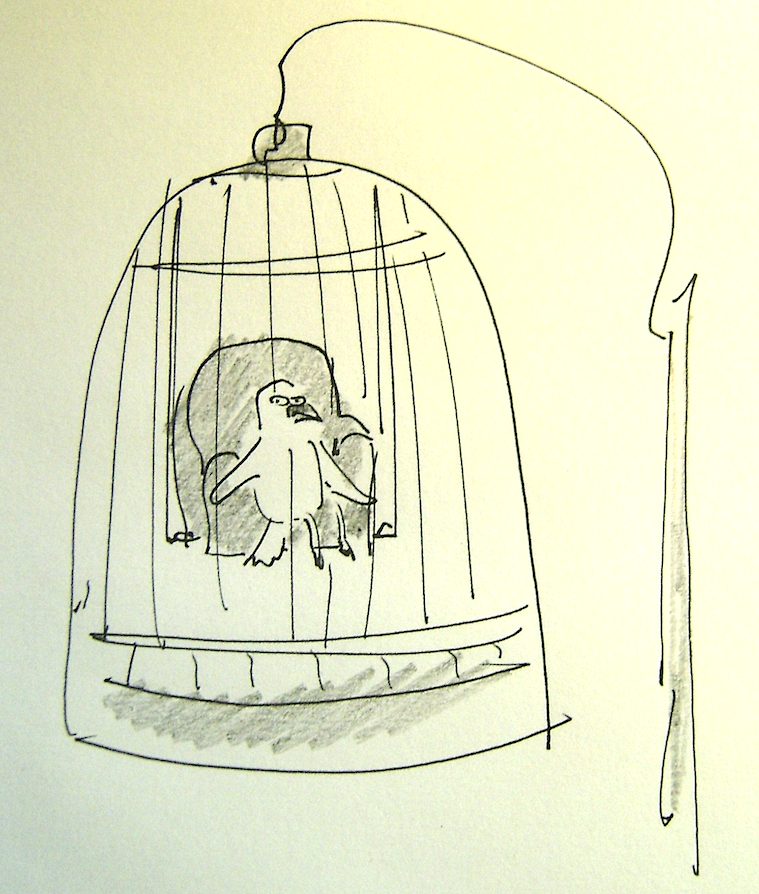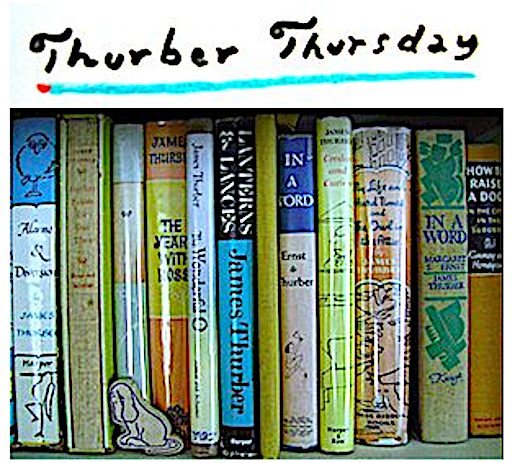Personal History: Reading Thurber for The Very First Time
I’ve always found it interesting that of all the stories I was assigned to read in junior high school and then later in high school, I only remember one. Not too long before I first saw a Thurber drawing (“What have you done with Dr. Millmoss?”) — perhaps a year, maybe two — I was sitting in an English class, when the teacher instructed us to open our thick english textbook and turn to a story titled “The Catbird Seat.” It was by a guy named James Thurber, who I’d never heard of. Before getting into the story, I recall being taken by the title. I’d heard the expression before, but hadn’t thought much, if anything, about it. I remember picturing a bird on a seat — in a cage, like this (something just drawn a few seconds ago, not back in English class in the 1960s…although it could’ve been):
 I wouldn’t have been clever enough to make the bird cat-like — my leanings were less complicated than that. The story itself seemed very “grownup” to me, especially as it mentioned “Camels” in the first sentence (camels the cigarettes, not “Lawrence Of Arabia” camels).
I wouldn’t have been clever enough to make the bird cat-like — my leanings were less complicated than that. The story itself seemed very “grownup” to me, especially as it mentioned “Camels” in the first sentence (camels the cigarettes, not “Lawrence Of Arabia” camels).
The subject was also grownup: murder (or at least, contemplated murder). The story was a bit complicated for my brain at the time — I was used to simpler fare (comic book story lines especially).
A year or so later, when the day came I first saw a Thurber drawing, I linked it to the author of “The Catbird Seat.” That too was a little confusing. A person drawing a cartoon also writes stories? It was an opening into the wider world of possibilities. “The Catbird Seat” happens to be included in The Thurber Carnival, the book where I first saw the Dr. Millmoss drawing. But at the time, seeing the drawing, revisiting a story was not of interest. In fact, I haven’t re-read “The Catbird Seat” until about twenty minutes ago. I can see now how the 13 or 14 year old me wouldn’t have connected much to the piece, other than the title, and the mention of cigarettes. Still, there was a connection, and it stuck. And it’s stayed stuck.
___________________________________
James Thurber’s A-Z entry:

James Thurber Born, Columbus, Ohio, December 8, 1894. Died 1961, New York City. New Yorker work: 1927 -1961, with several pieces run posthumously. According to the New Yorker’s legendary editor, William Shawn, “In the early days, a small company of writers, artists, and editors — E.B. White, James Thurber, Peter Arno, and Katharine White among them — did more to make the magazine what it is than can be measured.”
Key cartoon collection: The Seal in the Bedroom and Other Predicaments (Harper & Bros., 1932). Key anthology (writings & drawings): The Thurber Carnival (Harper & Row, 1945). There have been a number of Thurber biographies. Burton Bernstein’s Thurber (Dodd, Mead, 1975) and Harrison Kinney’s James Thurber: His Life and Times (Henry Holt & Co., 1995) are essential. Website
More: “The Catbird Seat” was originally published in The New Yorker, November 14, 1942. It was bookended by a full-page Gluyas Williams drawing and a full-page Perry Barlow drawing, with drawings by Leonard Dove and Ernest Maxwell sandwiched between.


